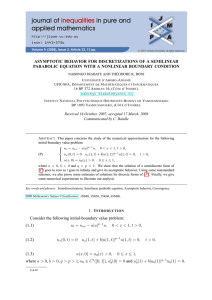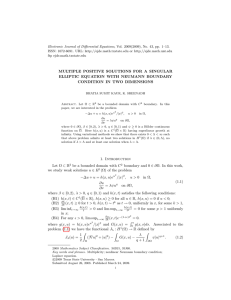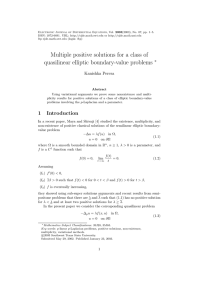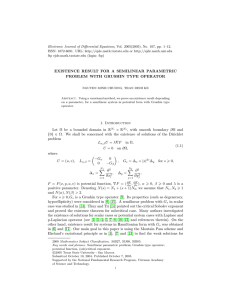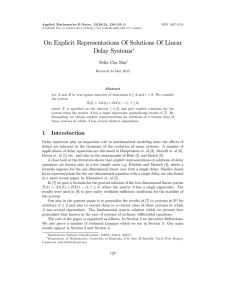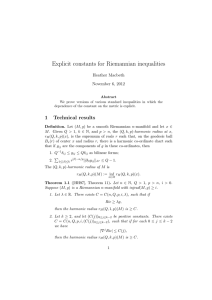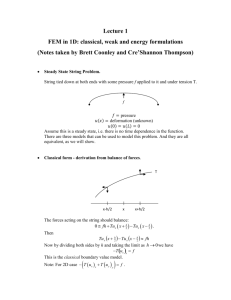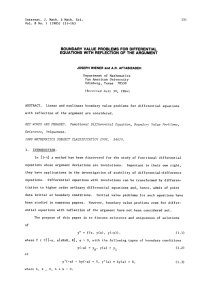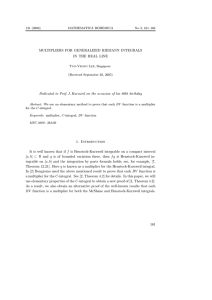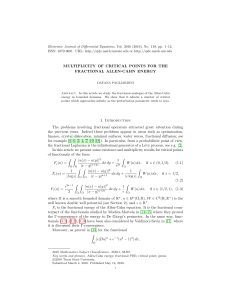Document 10749201
advertisement
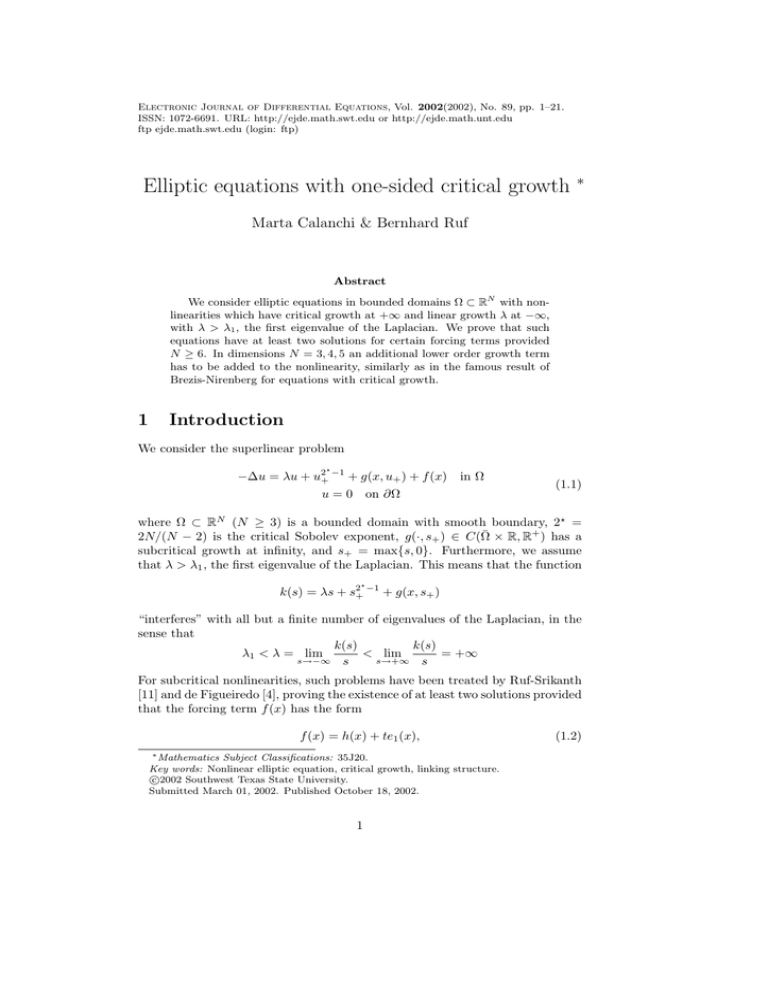
Electronic Journal of Differential Equations, Vol. 2002(2002), No. 89, pp. 1–21.
ISSN: 1072-6691. URL: http://ejde.math.swt.edu or http://ejde.math.unt.edu
ftp ejde.math.swt.edu (login: ftp)
Elliptic equations with one-sided critical growth
∗
Marta Calanchi & Bernhard Ruf
Abstract
We consider elliptic equations in bounded domains Ω ⊂ RN with nonlinearities which have critical growth at +∞ and linear growth λ at −∞,
with λ > λ1 , the first eigenvalue of the Laplacian. We prove that such
equations have at least two solutions for certain forcing terms provided
N ≥ 6. In dimensions N = 3, 4, 5 an additional lower order growth term
has to be added to the nonlinearity, similarly as in the famous result of
Brezis-Nirenberg for equations with critical growth.
1
Introduction
We consider the superlinear problem
?
−∆u = λu + u2+ −1 + g(x, u+ ) + f (x) in Ω
u = 0 on ∂Ω
(1.1)
where Ω ⊂ RN (N ≥ 3) is a bounded domain with smooth boundary, 2? =
2N/(N − 2) is the critical Sobolev exponent, g(·, s+ ) ∈ C(Ω̄ × R, R+ ) has a
subcritical growth at infinity, and s+ = max{s, 0}. Furthermore, we assume
that λ > λ1 , the first eigenvalue of the Laplacian. This means that the function
?
k(s) = λs + s2+ −1 + g(x, s+ )
“interferes” with all but a finite number of eigenvalues of the Laplacian, in the
sense that
k(s)
k(s)
< lim
= +∞
λ1 < λ = lim
s→+∞ s
s→−∞ s
For subcritical nonlinearities, such problems have been treated by Ruf-Srikanth
[11] and de Figueiredo [4], proving the existence of at least two solutions provided
that the forcing term f (x) has the form
f (x) = h(x) + te1 (x),
∗ Mathematics Subject Classifications: 35J20.
Key words: Nonlinear elliptic equation, critical growth, linking structure.
c
2002
Southwest Texas State University.
Submitted March 01, 2002. Published October 18, 2002.
1
(1.2)
2
Elliptic equations with one-sided critical growth
EJDE–2002/89
where h ∈ Lr (Ω), for some r > N , is given, e1 is the (positive and normalized) first eigenfunction of the Laplacian, and t > T , for some sufficiently large
number T = T (h).
We remark that the search of solutions for forcing terms of the form (1.2)
is natural if the nonlinearity crosses all eigenvalues, i.e. λ < λ1 (then the
problem is of so-called Ambrosetti-Prodi type);
R indeed, in this case there exists
an obvious necessary condition of the form Ω f e1 dx < c. In the present case
there does not seem to exist a necessary condition for solvability, and therefore
one might expect solutions for any forcing term in L2 (Ω). This is an open
problem; the only positive result known is for the corresponding ODE with
Neumann boundary conditions, cf. [7].
Equation (1.1) with nonlinearities with critical growth have recently been
considered by de Figueiredo - Jianfu [6], proving a similar existence result as the
one stated for the subcritical case, however with the restriction that the space
dimension N satisfies N ≥ 7. While it is known that in problems with critical
growth the low dimensions may show different behavior (see Brezis - Nirenberg [3], where different behavior occurs in dimension N = 3), it is somewhat
surprising to encounter difficulties already in the dimensions 4, 5 and 6.
The present work is motivated by the mentioned work of de Figueiredo and
Jianfu [6], who treated equation
?
−∆u = λu + u2+ −1 + f (x) in Ω
u = 0 on ∂Ω.
(1.3)
They established the existence of at least two solutions under suitable conditions
on f = h + te1 , more precisely they proved:
Theorem 1.1 (de Figueiredo - Jianfu [6]) Suppose that
i) λ > λ1
ii) h ∈ Lr (Ω), r > N , is given, with h ∈ ker(−∆ − λ)⊥ if λ is an eigenvalue.
Then there exists T0 = T0 (h) > 0 such that if t > T0 then problem (1.3) has a
negative solution φt ∈ W 2,r ∩ W01,r ⊂ C 1,1−N/r .
Suppose in addition that
iii) λ is not an eigenvalue of (−∆, H01 (Ω))
iv) N ≥ 7
Then problem (1.3) has a second solution for t > T0 .
We remark that in [6] only h ∈ L2 (Ω) is assumed, however this seems not
sufficient to get the stated results.
In this paper we improve and extend the result of de Figueiredo and Jianfu
in the following ways:
Main Results:
1) λ > λ1 and λ is not an eigenvalue:
N ≥ 6: if h ∈ Lr (Ω) (r > N ), then equation (1.1) has a second solution
for f = h + te1 , with t > T0 (h).
EJDE–2002/89
Marta Calanchi & Bernhard Ruf
3
N = 3, 4, 5: if h ∈ Lr (Ω) (r > N ) and g(x, s+ ) ≥ csq for some q = q(N ) >
1 and c > 0, then equation (1.1) has a second solution for f = h + te1 ,
with t > T0 .
2) λ is an eigenvalue, i.e. λ = λk , for some k ≥ 2: If h ∈ Lr (Ω) (r > N ) satisfies
h ⊥ ker(−∆ − λk , H01 (Ω)), then equation (1.1) has a second solution for
f = h + te1 with t > T0 (in dimensions N = 3, 4, 5 the assumptions made
in 1) have to be added).
3) λ in a left neighborhood of λk , k ≥ 2: There exists a δ > 0 such that if
λ ∈ (λk − δ, λk ) and h ∈ Lr (Ω) (r > N ) satisfies h ⊥ ker(−∆, H01 (Ω),
then equation (1.1) has at least three solutions for f = h+te1 , with t > T0
(in dimensions N = 3, 4, 5 the assumptions made in 1) have to be added).
For proving these statements, one proceeds as follows: the first (negative)
solution is easily obtained (see [11], [4], [6]). To obtain a second solution, one
uses the saddle point structure around the first solution and applies the generalized mountain pass theorem of Rabinowitz [10]. To prove the Palais-Smale
condition, one proceeds as in [3], using a sequence of concentrating functions
(obtained from the so-called Talenti function). However due to the presence of
the first solution, lower order terms appear in the estimates. To handle these
estimates, an “orthogonalization” procedure based on separating the supports
of the Talenti sequence and the (approximate) first solution is used (this approach was introduced in [8]). With this method we obtain the results 1) and
2).
To prove 3), one shows that the “branch” of solutions with λ ∈ (λk , λk+1 ) can
be extended to λ = λk if h ⊥ ker(−∆). Actually, this branch can be extended
slightly beyond λk , i.e. to λ ∈ (λk − δ, λk ], and the corresponding solutions are
clearly bounded away from the negative solution. Since in λk starts a bifurcation
branch (λ, u) emanating from the negative solution and bending to the left (as
shown by de Figueiredo - Jianfu [6]), we conclude that for λ to the left of and
close to λk there exist at least three solutions.
2
Statement of theorems
In this section we give the precise statements of the theorems. Furthermore, the
notation and basic properties are introduced. We consider problem (1.1) under
the following conditions on the nonlinearity g:
(g1 ) g : Ω̄ × R → R+ is continuous;
(g2 ) g(x, s) ≡ 0 for s ≤ 0, i.e. g(x, s) = g(x, s+ ) with g(x, 0) = 0;
(g3 ) There exist constants c1 > 0 and 1 < p < (N + 2)/(N − 2) such that
g(x, s) ≤ c1 |s|p , for all s ∈ R;
For N = 3, 4, 5 we assume in addition:
4
Elliptic equations with one-sided critical growth
(g4 ) There exist c > 0 and q with max
g(x, s+ ) ≥ c(s+ )q , for all s ∈ R.
n
N
2(N −1)
,
2
3
o
<
EJDE–2002/89
q+1
2?
< 1, such that
We prove the following results:
Theorem 2.1 N ≥ 6: Let h ∈ Lr (Ω), r > N , be given, and let T0 = T0 (h)
the number given by Theorem 0. Assume that λ > λ1 , and that g satisfies
(g1 ), (g2 ), (g3 ). If λ is an eigenvalue, say λ = λk , assume in addition that
h ⊥ ker(−∆ − λk ). Then problem (1.1) has a second solution for f = h + te1 ,
with t > T0 .
Theorem 2.2 3 ≤ N ≤ 5: Let h ∈ Lr , r > N , be given, and suppose that all
other assumptions of Theorem 2.1 are satisfied. If g satisfies also (g4 ), then
problem (1.1) has a second solution for f = h + te1 , with t > T0 .
Theorem 2.3 Assume the hypotheses of Theorems 2.1 and 2.2, and assume in
addition that h ⊥ ker(−∆ − λk ), for some k ≥ 2. Then there exists δ > 0 such
that for λ ∈ (λk −δ, λk ) problem (1.1) has at least three solutions for f = h+te1 ,
with t > T0 .
The first solution of equation (1.1) is a negative solution, and its existence,
for t sufficiently large, is not difficult to prove (see [4], [6]): first note that a
negative solution satisfies the linear equation
−∆y − λy = h + te1 in Ω
y = 0 on ∂Ω
(2.1)
The solution of this equation is unique, and we denote it, in dependence of
te1 , by φt (we remark that if λ = λk then h ⊥ ker(−∆ − λk ) is required, and
⊥
the
R solution is unique in (ker(−∆ − λk )) ). Note that we may assume that
RΩ he1 dx = 0, and then the solution φt can be written as φt = w + st e1 , with
we1 dx = 0 and st = t/(λ1 − λ) (and with w ⊥ ker(−∆ − λk ) if λ = λk ).
Ω
Since h ∈ Lr , r > N , we have w ∈ C 1,1−N/r (Ω), and it is known (see [9]) that
∂
e1 (x) is positive; hence φt < 0 for t
on ∂Ω the (interior) normal derivative ∂n
sufficiently large.
To find a second solution of equation (1.1), we set u = v + φt ; then v solves
?
2 −1
−∆v = λv + (v + φt )+
+ g(x, (v + φt )+ )
v = 0 on ∂Ω
in Ω
(2.2)
Clearly v = 0 is a solution of this equation, corresponding to the negative
solution φt for equation (1.1). To find a second solution of equation (2.2) one
can look for non trivial critical points of the functional
Z
Z
Z
1
1
2
2
2?
J(v) =
(v + φt )+ dx −
G(x, (v + φt )+ )dx,
(|∇v| − λv )dx − ?
2 Ω
2 Ω
Ω
Rs
where G(x, s) := 0 g(x, ξ) dξ.
EJDE–2002/89
Marta Calanchi & Bernhard Ruf
5
This was the approach of de Figueiredo-Jianfu in [6]. For applying the
Generalized Mountain Pass theorem of Rabinowitz [10] one needs to prove some
geometric estimates. Furthermore, since the nonlinearities have critical growth,
one needs to show that the minimax level avoids the non-compactness levels
given by the “concentrating sequences” u (see [3] and below).
In these estimates, the terms of the form v + φt + u are not easy to handle.
In this paper we apply a method introduced in [8] to make such estimates easier.
The idea consists in separating the supports of v + φt and u by concentrating
the support of the functions u in small balls, and “cutting small holes” into the
functions v + φt such that the respective supports are disjoint. These manipulations create some errors, but these are easier to handle than to estimate the
“mixed terms” arising in expressions like (v + φt + u )p+ . Moving these “small
holes” near ∂Ω where the first solution φt is small allows to further improve the
estimates.
3
Variational setting and preliminary properties
We begin by replacing equation (2.2) by an approximate equation. We denote
by Br (x0 ) ⊂ Ω a ball of radius r and center x0 ∈ Ω. Choose m ∈ N so large that
B2/m (x0 ) ⊆ Ω, and let ηm ∈ C0∞ (Ω) such that 0 ≤ ηm (x) ≤ 1, |∇ηm (x)| ≤ 2m
and
(
0 in B1/m (x0 )
ηm (x) =
1 in Ω \ B2/m (x0 )
Define the functions φm
t = ηm φt and set
m
fm = −∆φm
t − λφt .
m
Setting as before u = v + φm
t in equation (1.1), we see that then v = φt − φt
solves the equation
?
2 −1
−∆v = λv + (v + φm
+ g(x, (v + φm
t )+
t )+ ) + (f − fm ) in Ω
v = 0 on ∂Ω
(3.1)
Clearly v = φt − φm
t corresponds to the trivial solution of this equation; for
finding other solutions of (3.1) we look for critical points of the functional,
J : H → R,
Z
Z
1
1
2?
J(v) =
(|∇v|2 − λv 2 ) − ?
(v + φm
t )+
2 Ω
2 Ω
Z
Z
m
−
G(x, (v + φt )+ ) − (f − fm )v ,
Ω
Ω
where H denotes
the Sobolev space H = H01 (Ω), equipped with the Dirichlet
R
norm kuk = ( Ω |∇u|2 dx)1/2 .
We begin by estimating the “error” given by the term f − fm .
6
Elliptic equations with one-sided critical growth
EJDE–2002/89
Lemma 3.1 For N ≥ 3, as m → +∞ we have:
−N/2
kφt − φm
;
t k ≤ cm
Z
(f − fm )ψ dx ≤ ckψkm−N/2 , for all ψ ∈ H.
(3.2)
(3.3)
Ω
Proof. Note first that by the regularity assumption h ∈ Lr , r > N , it follows
that φt ∈ C 1,1−N/r (Ω), and hence in particular that there exists c > 0 such that
for any point x̄ ∈ ∂Ω
|φt (x)| ≤ c|x − x̄|.
Furthermore we may choose for every large m ∈ N a point x0 at distance 4/m
from the boundary point x̄, such that
|φt (x)| ≤
c1
,
m
∀x ∈ B4/m (x0 ).
(3.4)
We may assume that x0 = 0 for every choice of m; from now on we write
Br = Br (0). Thus, we can estimate
Z
2
|∇(φt − φm
t )|
Ω
Z
=
|∇φt (1 − ηm ) − φt ∇ηm |2
Ω
Z
Z
2
2
=
|∇φt | |1 − ηm | − 2
|∇φt |(1 − ηm )|φt | |∇ηm |
B
+
B
2
Zm
B
2
m
\B
1
m
|φt |2 |∇ηm |2
2
m
\B
1
m
≤c1 m−N + c2 m−N + c3 m−N = cm−N ,
hence (3.2). The estimate (3.3) is now obtained as follows:
Z
Z
m
|∇(φt − φm
(f − fm )ψ dx =
t )∇ψ − λ(φt − φt )ψdx
Ω
Ω
−N/2
≤ckφt − φm
,
t k kψk ≤ ckψkm
for all ψ ∈ H.
Let λ1 < λ2 ≤ . . . the eigenvalues of −∆ and e1 , e2 . . . , the corresponding
eigenfunctions. Take m as before and let ζm : Ω → R be smooth functions such
that 0 ≤ ζm ≤ 1, |∇ζm | ≤ 4m and
(
0 if x ∈ B2/m
ζm (x) =
1 if x ∈ Ω \ B3/m
We define “approximate eigenfunctions” by em
i = ζm ei . Then the following
estimates hold.
EJDE–2002/89
Marta Calanchi & Bernhard Ruf
7
Lemma 3.2 As m → ∞, we have em
i → ei in H. Moreover, in the space
−
m
Hj,m
= span{em
,
.
.
.
,
e
},
we
have
1
j
Z
n
o
−
max kuk2 : u ∈ Hj,m
,
u2 = 1 ≤ λj + cj m−N
Ω
and
Z
m
−N
∇em
).
i ∇ej dx = δij + O(m
Ω
Proof. See [8] and observe that, since ∂Ω is of class C 1 , also for the eigenfunctions ei an estimate as (3.4) holds.
Consider the family of functions
h pN (N − 2)ε i(N −2)/2
?
uε (x) =
ε2 + |x|2
which are solutions to the equation
?
−∆u = |u|2 −2 u in RN
u(x) → 0 as |x| → ∞
∗
and which realize the best Sobolev embedding constant H 1 (RN ) ⊂ L2 (RN ),
i.e. the value
kukH
.
S = SN = inf
u6=0 kukL2∗
Let ξ ∈ C01 (B1/m ) be a cut–off function such that ξ(x) = 1 on B1/2m , 0 ≤
ξ(x) ≤ 1 in B1/m and k∇ξk∞ ≤ 4m.
Let uε (x) := ξ(x)u?ε (x) ∈ H. For ε → 0 we have the following estimates due
to Brezis and Nirenberg
Lemma 3.3 (Brezis-Nirenberg, [3]) For fixed m we have
(a) kuε k2 = S N/2 + O(εN −2 )
?
(b) kuε k22? = S N/2 + O(εN )
(c) kuε k22 ≥ K1 ε2 + O(εN −2 )
(d) kuε kss ≥ K2 εN −
N −2
2 s
.
Moreover, for m → ∞ and ε = o(1/m), we have (see [8])
(e) kuε k2 = S N/2 + O((εm)N −2 )
?
(f ) kuε k22? = S N/2 + O((εm)N )
while (c) and (d) hold independently of m.
8
Elliptic equations with one-sided critical growth
Proof.
EJDE–2002/89
We only prove (d); for the other estimates, see [3, 8, 12].
Z
Z
N2−2 s
ε
s
uε dx ≥c
dx
ε2 + |x|2
Ω
B 1
2m
Z ε
N −2
ε N2−2 s N −1
≥c
ρ
dρ ≥ cε− 2 s εN .
2
2
ε +ρ
0
which completes the proof.
4
The linking structure
In this section we prove that the functional J has a “linking structure” as
required by the Generalized Mountain Pass Theorem by P. Rabinowitz [10]. For
the rest of this article, we assume λ ∈ [λk , λk+1 ). Let H + = [span{e1 , . . . , ek }]⊥ ,
−
m
ε
−
Sr = ∂Br ∩ H + , Hm
= span{em
1 , . . . , ek } and Qm = (BR ∩ Hm ) ⊕ [0, R]{uε },
ε
where
m ∈ N is fixed. Define the family of maps H = {h : Qm → H continuous :
h∂Qε = id}, and set
m
c̄ = inf sup J(u)
(4.1)
h∈H u∈h(Qε )
m
Then the Generalized Mountain Pass theorem of P. Rabinowitz states that if
1) J : H → R satisfies the Palais-Smale condition (PS)
2) there exist numbers 0 < r < R and α1 > α0 such that
J(v) ≥ α1 , for all v ∈ Sr
J(v) ≤ α0 , for all v ∈ ∂Qεm ,
(4.2)
(4.3)
then the value c̄ defined by (4.1) satisfies c̄ ≥ α1 , and it is a critical
value for J.
−
First note that for v ∈ Hm
⊕ R{uε }, v = w + suε , we have by definition
supp(uε ) ∩ supp(w) = ∅. It is easy to prove that this implies that
J(v) ≡ J(w + suε ) = J(w) + J(suε ) .
We begin by showing that the functional J satisfies condition (4.2).
Lemma 4.1 There exist numbers r > 0 and α1 > 0 such that
for all v ∈ Sr = ∂Br ∩ H +
J(v) ≥ α1
Proof. Let v ∈ H + . From the variational characterization of λk+1 and the
Sobolev embedding theorem, we have, using (g3 ) and Lemma 3.1,
Z
Z
Z
Z
λ 1
1
p+1
2?
1−
|∇v|2 − ?
v+
−c
v+
− (f − fm )v
J(v) ≥
2
λk+1 Ω
2 Ω
Ω
Ω
?
≥ c1 kvk2 − c2 kvk2 − c3 kvkp+1 − c4 m−N/2 kvk
EJDE–2002/89
Marta Calanchi & Bernhard Ruf
9
?
Let km (s) = c1 |s|2 − c2 |s|2 − c3 |s|p+1 − c4 m−N/2 |s|. Clearly, there exists m0
such that maxR km (s) = Mm ≥ Mm0 > 0 for all m ≥ m0 . Thus there exist
α1 > 0 and r > 0 such that
J(v) ≥ α1 > 0 for kvk = r.
which completes the proof.
Next we prove condition (4.3).
Lemma 4.2 There exist R > r and α0 < α1 such that for ε sufficiently small
J ∂Qε < α0 .
m
−
Proof. Let v = w + suε ∈ (Hm
∩ B̄R ) ⊕ [0, R]{uε ]. Since J(v) = J(w) + J(suε )
we can estimate J(w) and J(suε ) separately.
Z
Z
Z
1
λ
1
2?
|∇w|2 dx −
|w|2 dx − ?
(w + φm
J(w) ≤
t )+ dx ,
2 Ω
2 Ω
2 Ω
R
R
R
m
since Ω (f − fm )w dx = Ω ∇(φt − φt )∇w dx − λ Ω (φt − φm
t )w dx = 0.
Z
Z
s2
λs2
J(suε ) ≤
|∇uε |2 dx −
|uε |2 dx
2 B1
2 B1
m
Z
? Z m
s2
2?
−
|uε | dx −
f suε dx.
2? B 1
B1
m
Let
∂Qεm
m
= Γ1 ∪ Γ2 ∪ Γ3 , where
Γ1
Γ2
Γ3
−
= {v ∈ H : v = w + suε , w ∈ Hm
, kwk = R, 0 ≤ s ≤ R},
−
= {v ∈ H : v = w + Ruε , w ∈ Hm
∩ B̄R },
−
= Hm
∩ B̄R .
Note that it follows by Lemma 3.2 that
Z
Z
2
−N
|∇w| dx ≤ (λk + ck m )
|w|2 dx,
Ω
−
for all w ∈ Hm
Ω
1. Suppose v ∈ Γ1 ; then v = w + suε with kwk = R and 0 ≤ s ≤ R.
k
(i) if λ ∈ (λk , λk+1 ), we choose m0 such that ck m−n < λ−λ
2 , for m ≥ m0 .
Then, using Lemma 3.3
Z
Z
1
λ
1
2
2?
J(v) ≤ 1 −
|∇w|
dx
−
(w + φm
t )+ dx
−N
?
2
λk + ck m
2 Ω
Ω
? Z
2 Z
2 Z
?
s
λs
s2
|∇uε |2 dx −
u2ε dx − ?
u2ε dx + skf k2 kuε k2
+
2 B1
2 B1
2 B1
m
m
?
m
s2
?
s2 ≤ − cR2 + S N/2
− ? + R2 O(εN ) + R2 O(εN −2 ) + cs
2
2
?
≤ − cR2 + c1 + c2 R + c3 R2 εN −2 .
10
Elliptic equations with one-sided critical growth
EJDE–2002/89
Thus J(v) ≤ 0 for R ≥ R0 and ε > 0 sufficiently small.
−
(ii) if λ = λk , for w = Rw̄ ∈ Hm
with kw̄k = 1 we write w̄ = αy + βem
k , with
m
m
y ∈ span{e1 , . . . , ek−1 } and kyk = 1. Then
J(w) =
R2
2
?
Z
2
m 2
(|α∇y + β∇em
k | − λk |αy + βek | ) dx −
Ω
R2
2?
Z
w̄ +
Ω
φt 2?
dx.
R +
Using Lemma 3.2, we can estimate the first integral as follows
Z
2
m 2
(|α∇y + β∇em
k | − λk |αy + βek | ) dx
Ω
λk
λk
≤ α2 1 −
+ β2 1 −
λk−1 + cm−N
λk + cm−N
Z
m
+2αβ (∇y∇em
k − λk yek ) dx
Ω
≤
−cα2 + c1 (β 2 + 2αβ)m−N .
Note now that if |α| ≥ δ > 0, for some δ > 0, then
J(w) ≤ −
cδ 2 R2
+ c1 m−N
2
and hence J(v) ≤ 0 for R ≥ R1 (δ).
We show now that there exists δ > 0 such that if |α| ≤ δ, then there exist
constants c2 > 0 and R2 > 0 such that
Z
φt 2?
w̄ +
≥ c2 > 0
R +
Ω
−
for all R ≥ R2 and for all w ∈ Hm
∩ ∂BR . To this aim we prove that there exist
δ > 0 and η > 0 such that
max(αy + βem
k )≥η >0
Ω̄
−
for all y ∈ Hk−1,m
, kyk = 1, |α| ≤ δ .
−
By contradiction assume that there exist sequences |αn | ≤ 1/n, yn ∈ Hk−1,m
with kyn k = 1 such that
max{αn yn + βn em
k }→0
Ω̄
as
n → +∞.
Then αn yn → 0, βn2 = 1 − αn2 + O(m−N ) → β 2 = 1 + O(m−N ) ≥ 1/2, for
m ≥ m0 . Therefore, we conclude that
2
max(βem
k ) = 0 , with β ≥
Ω̄
1
+
for m ≥ m0 i.e. (em
k ) = 0.
2
m
This is a contradiction since em
k → ek in H implies that ek must change sign,
for m large. Therefore, there exist δ > 0, η > 0 such that
−
max {w̄, |α| ≤ δ} ≥ η > 0 , ∀w̄ ∈ Hk,m
, kw̄k = 1, m ≥ m0 .
Ω̄
EJDE–2002/89
Marta Calanchi & Bernhard Ruf
11
−
Denoting Ωw̄ = {x ∈ Ω : w̄(x) ≥ η/2}, then |Ωw̄ | ≥ ν > 0, ∀w̄ ∈ Hk,m
, with
−
kw̄k = 1 and |α| ≤ δ, m ≥ m0 , since the functions w̄ ∈ Hk,m are equicontinuous.
Moreover
φt
η
>−
for R sufficiently large .
R
4
Then
Z
η ?
φt ?
(w̄ + )2+ ≥ ( )2 |Ωw̄ |.
R
4
Ω
Thus, we can conclude that there exists R2 > 0 such that
Z
?
? η
∗
φt ∗
J(w) ≤ cR2 − R2
(w̄ + )2+ ≤ cR2 − R2 ( )2 ν ≤ 0 ,
R
4
Ω
for all R ≥ R2 . In particular J(w) → −∞ as R → +∞.
2. Let v ∈ Γ2 , i.e. v = w + Ruε with kwk ≤ R. Then
J(v) =J(w) + J(Ruε )
≤cm−N kwk2 +
R2
2
?
Z
B
|∇uε |2 dx −
1
m
R2
2?
Z
?
u2ε dx + Rkf k2 kuε k2 < 0 ,
Ω
for R sufficiently large. Now fix R > 0 such that the previous estimates hold.
−
3. Let v ∈ Γ3 , i.e. v = w ∈ Hm
∩ BR . Hence
Z
?
1
(w + φt )2+ ≤ α0
J(v) ≤ c1 m−N kwk2 − ?
2 Ω
if m is sufficiently large.
5
Existence of a second solution
In this section we prove Theorems 2.1 and 2.2. By the Linking Theorem we construct a Palais–Smale sequence {vn } ⊂ H at the minimax level c̄; the sequence
{vn } satisfies
Z
Z
1
1
2
2
2?
J(vn ) =
(|∇vn | − λvn ) dx − ?
(vn + φm
t )+ dx
2 Ω
2 Ω
Z
Z
(5.1)
−
G(x, (vn + φm
)
)
dx
+
(f
−
f
)v
dx
=
c̄
+
o(1)
m n
t +
Ω
Ω
and
hJ 0 (vn ), zi =
Z
Z
2? −1
(∇vn ∇z − λvn z) dx − (vn + φm
z dx
t )+
Ω
Ω
Z
Z
−
g(x, (vn + φm
)
)z
dx
+
(f − fm )z dx = o(1)kzk
t +
Ω
for all z ∈ H.
Ω
(5.2)
12
Elliptic equations with one-sided critical growth
EJDE–2002/89
Lemma 5.1 Under the hypotheses of Theorem 2.1 or Theorem 2.2, the sequence
{vn } is bounded in H.
Proof.
¿From (5.1) and (5.2), it follows that
1
J(vn ) − hJ 0 (vn ), vn i
2Z
Z
1
1
2? −1 m
2?
=
(vn + φm
)
−
(vn + φm
φt
t +
t )+
N Ω
2 Ω
Z
Z
Z
1
1
m
−
G(x, (vn + φm
)
)
+
g(x,
(v
+
φ
)
)v
−
(f − fm )vn
+
n
+
n
t
t
2 Ω
2 Ω
Ω
= c̄ + o(1) + o(1)kvn k
Therefore, using that φm
t ≤ 0 and Lemma 4,
Z
Z
1
2?
(vn + φm
)
dx
≤
G(x, (vn + φm
t +
t )+ ) dx
N Ω
Ω
Z
1
m
−
g(x, (vn + φm
t )+ )(vn + φt ) dx
2 Ω
+c + (o(1) + dm−N )kvn k
Then by (g3 ), we get
Z
2?
(vn + φm
t )+ dx
Ω
Z
p+1
−N
≤ c1 (vn + φm
)kvn k
t )+ dx + c + (o(1) + dm
Ω
≤ c1
Z
?
2
(vn + φm
t )+ dx
Ω
p+1
2?
+ c + (o(1) + dm−N )kvn k
Since p + 1 < 2? , we obtain
Z
?
(vn + φt )2+ dx ≤ c + (o(1) + dm−N )kvn k ≤ c1 + c2 kvn k
(5.3)
Ω
(i) First we consider the case λ ∈ (λk , λk+1 ). Let vn = vn+ + vn− (as in [6]), with
vn− ∈ Hk− = span{e1 . . . ek } and vn+ ∈ (Hk− )⊥ . We obtain
Z
Z
2? −1 +
0
+
+ 2
+ 2
hJ (vn ), vn i =
(|∇vn | − λ(vn ) ) dx − (vn + φm
vn dx
t )+
Ω
Ω
Z
Z
+
+
−
g(x, (vn + φm
(f − fm )vm
dx = o(1)kvn+ k
t )+ )vn dx −
Ω
Ω
EJDE–2002/89
Marta Calanchi & Bernhard Ruf
13
From the variational characterization of λk+1 we get, using the Hölder and
Young inequalities and (5.3),
λ + 2
kvn k
λk+1
Z
Z
p +
2? −1 +
+
−N
≤
(vn + φm
)
v
+
c
(vn + φm
kvn+ k
t +
n
t )+ |vn | + o(1)kvn k + dm
Ω
Z Ω
Z
2/2?
2(2? −1)
+ 2?
2?
2?
≤ ε
|vn |
+ cε ( (vn + φm
t )+ )
1−
Ω
Ω
2? −p
Z
p/2? Z
? 2?
m 2?
+ 2?2−p
+ ckvn+ k
+c
(vn + φt )+
|vn |
Ω
Ω
2? −p
2(22??−1)
Z
? 2
2?
2
+ 2?2−p
≤ εkvn+ k2 + cε
(vn + φm
)
+
ε
|v
|
t +
n
Ω
Ω
Z
?
? 2p/2
2
+cε
(vn + φm
+ ckvn+ k
t )+
Z
?
Ω
By (5.3) and by the Sobolev embedding theorems, we obtain
kvn+ k2 ≤ c + o(1) kvn k
For vn− ∈ H − , we have
Z
λ
(
− 1)
|∇vn− |2
λk
Z Ω
Z
2? −1 −
≤
(vn + φm
)
|v
|
+
t +
n
Ω
N +2
N
2p + kvn k 2? + ckvn+ ||
−
g(x, (vn + φm
t )+ )|vn | +
Z
Ω
(5.4)
|f − fm ||vn− |
Ω
In the same way we obtain
kvn− k2H 1 ≤ c̄ + o(1) kvn k
N +2
N
2p + kvn k 2? + ckvn− k
(5.5)
Joining (5.4) and (5.5), we find
kvn k2 ≤ c + c(kvn k
N +2
N
2p
+ kvn k 2? ) + ckvn k,
so vn is bounded in H.
(ii) If λ = λk we write vn = vn− + vn+ + βn ek = wn + βn ek , where we denote with
−
vn− and vn+ the projections of vn onto the subspace Hk−1
= span{e1 , . . . , ek−1 }
and Hk+ = (Hk− )⊥ respectively. With a similar argument as above we obtain
the following estimate
2p N +2
kwn k2 ≤ c + c kvn k N + kvn k 2? + ckwn k
(5.6)
We can assume kvn k ≥ 1. Then, from (5.6), we have
2p
2p
kwn k2 ≤ c + ckvn k 2? ≤ c + c(kwn k + |βn |) 2?
(5.7)
14
Elliptic equations with one-sided critical growth
EJDE–2002/89
If βn is bounded we conclude as above. If not, we may assume βn → +∞ and
kwn k → +∞ (we neglect the case kwn k ≤ c which is much easier). Therefore,
from (5.7),
1
p/2?
kwn k2 ≤ (kwn k + βn2 )
.
2
p/2?
p
n
Then kwn k ≤ cβn
and k w
βn k → 0 since 2? < 1. Therefore, possibly up to a
subsequence, wn /βn → 0 a.e. and strongly in Lq , 2 ≤ q < 2? . Therefore, for all
q ∈ (2, 2? )
Z
Z
wn + φm
t
+ ek )q+ ek dx →
(ek )q+1
(5.8)
(
+ dx.
βn
Ω
Ω
Moreover, since
o(1)
= hJ 0 (vn ), ek i
Z
Z
Z
2? −1
m
= − (vn + φm
)
e
−
g(x,
(v
+
φ
)
)e
+
(f − fm )ek
k
n
t +
t + k
Ω
Ω
Ω
we get, using (g3 )
Z
Z
2? −1
p
wn + φm
c
wn + φm
t
t
+ ek + ek ≤ o(1) + 2? −1−p
+ ek + ek .
βn
βn
βn
Ω
Ω
Finally, by (5.8) we get
Z
?
(ek )2+ ≤ 0
Ω
which is a contradiction. Thus (vn ) is bounded.
Returning to relation (5.2), we may therefore assume, as n → +∞: vn * v
weakly in H01 , vn → v in Lq 2 ≤ q < 2? and vn → v a. e. in Ω. In particular,
it follows that v is a weak solution of
?
2 −1
−∆v = λv + (v + φm
+ g(x, (v + φm
t )+
t )+ ) + f − fm
v = 0 on ∂Ω
in Ω
(5.9)
To conclude the proof, It remains to show that v 6= φt − φm
t , the “trivial”
solution of (5.9). First, we estimate
J(φt − φm
)
Zt
Z
Z
λ
1
2
m 2
|∇(φt − φm
)|
−
|φ
−
φ
|
−
(f − fm )(φt − φm
=
t
t
t
t )
2 Ω
2 Ω
Ω
Z
1
2
m 2
= −
|∇(φt − φm
t )| − λ|φt − φt | .
2 Ω
From Lemma 3.1 we get, taking εβ =
1
m
0 < β < 1,
−N
|J(φt − φm
:= cεβN .
t )| ≤ cm
(5.10)
EJDE–2002/89
Marta Calanchi & Bernhard Ruf
15
Since v is a weak solution of (5.9), we have
Z
Z
Z
2? −1 m
2?
(|∇v|2 − λv 2 ) dx − (v + φm
)
dx
+
(v + φm
φt dx
t +
t )+
Ω
Ω
ZΩ
Z
−
g(x, (v + φm
(f − fm )v dx =
t )+ )v dx −
Ω
By the Brezis–Lieb Lemma ([2])
Z
Z
Z
m 2?
2?
2?
(vn + φt )+ dx = (vn − v)+ dx + (v + φm
t )+ dx + o(1)
Ω
0
Ω
Ω
(5.11)
Ω
Since vn → v in Lq 2 ≤ q < 2? , we have
Z
Z
G(x, (vn + φm
)
)
dx
−
G(x, (v + φm
t +
t )+ ) dx = o(1).
Ω
(5.12)
Ω
Since vn * v in H,
Z
2
|∇vn | =
Z
Z
2
|∇v| +
|∇(vn − v)|2 + o(1).
(5.13)
Then, by (5.1), (5.11) and (5.13), we find
c̄ + o(1)
= J(vn )
(5.14)
1
2
= J(v) +
Z
|∇(vn − v)|2 dx −
Ω
1
2?
Z
?
(vn − v)2+ dx + o(1)
Ω
0
Similarly, since J (v) = 0, we obtain
Z
Z
Z
?
?
hJ 0 (vn ), vn i =
|∇(vn − v)|2 − (vn − v)2+ − (vn − v)2+ −1 φm
t
Ω
Ω
Ω
Z
Z
−
g(x, (vn + φm
g(x, (v + φm
t )+ )vn +
t )+ )v + o(1).
Ω
Ω
Since
Z
?
(vn − v)2+ −1 φm
t dx = o(1)
Ω
and
Z
g(x, (vn + φm
t )+ )vn dx −
Z
Ω
g(x, (v + φm
t )+ )v dx = o(1),
Ω
we get
Z
|∇(vn − v)|2 dx =
Ω
Z
?
(vn − v)2+ dx + o(1).
Ω
Now, let
K = lim
n→+∞
Z
Ω
|∇(vn − v)|2 dx.
(5.15)
16
Elliptic equations with one-sided critical growth
EJDE–2002/89
?
If K = 0, then vn → v strongly in H and in L2 ; then by (5.14) and (5.10)
J(v) = c̄ ≥ α1 > cεβN ≥ J(φt − φm
t )
so that v 6= φt − φm
t . If K > 0, using the Sobolev inequality and (5.15), we have
(as in [6])
Z
2/2?
Z
2/2?
?
?
kvn − vk2 ≥ S
|vn − v|2 dx
≥S
(vn − v)2+ dx
Ω
Ω
Z
2/2?
2
≥ S
|∇(vn − v)| dx + o(1)
Ω
N −2
This implies that K ≥ SK N , that is K ≥ S N/2 .
To complete the proof we use the following Lemmas which will be proved
below.
Lemma 5.2 Under the hypotheses of Theorem 2.1 one has, for εβ = 1/m, with
α/N < β < (N − 4)/(N − 2),
1 N/2
S
− cε2 .
(5.16)
N
Lemma 5.3 Suppose that the hypotheses of Theorem 2.22 are satisfied. Then
for εβ = 1/m, with
c̄ <
2(N − 1)
1
2
N −2
max 1 −
(q + 1),
− (q + 1) < β < (q + 1) −
,
2N
N −2
2
N −2
we have
N −2
1 N/2
S
− cεN − 2 (q+1) .
N
By (5.14) and (5.15) we get
(
cε2
(Theorem 2.1)
1 N/2
K
= c̄ ≤ S
−
J(v) +
N −2
N
−
(q+1)
2
N
N
(Theorem 2.2)
cε
c̄ <
Assume now by contradiction that v ≡ φt − φm
t . Then we get by (5.10)
K
1
+ J(v) ≥ S N/2 − cεβN
N
N
which is impossible, due to the choice of β.
Proof of Lemma 5.2. Let ε > 0 and m ∈ N be fixed such that the hypotheses
of the Linking Theorem are satisfied. For v = w + suε , we have
J(v)
= J(w) + J(suε )
Z
Z
? Z
?
s2
s2
λs2
≤ J(w) +
|∇uε |2 − ?
u2ε −
u2
2 B1
2 B1
2 B1 ε
m
m
m
Z
+s
|f − fm | |uε |
B
1
m
EJDE–2002/89
Marta Calanchi & Bernhard Ruf
17
As above, we have J(w) ≤ cm−N .
To estimate the last inequality we use the argument developed in [8] (Lemma
3.1). We have from (e) and (f) in Lemma 3.3
s2
2
?
s2
|∇uε | − ?
2
B1/m
Z
2
?
Z
s2
s2 ≤ ( − ? ) S N/2 + O((εm)N −2 )
2
2
1 1
≤ ( − ? ) S N/2 + O((εm)N −2 )
2 2
S N/2
≤
+ c(εm)N −2 .
N
?
u2ε
B1/m
2?
2
(since s2 − s2? attains its maximum at s = 1)
We make use of the Hölder inequality to estimate the last term. Let α be
such that α1 + 1r + 12 = 1, i.e. α1 = 12 − 1r > 12 − N1 = 21? , in particular 2? > α.
Since supp fm ⊆ Ω\B1/m we have
Z
|f − fm | |uε |
B1/m
≤
Z
|f |r
B1/m
−N/α
≤ cεm
1/r Z
|uε |2
B1/m
1/2
(µ(B1/m ))1/α
.
If εβ = 1/m with 0 < β < 1 we have, by (c) in Lemma 3.3,
1 N/2
S
+ c1 m−N + c2 (εm)N −2 − c3 ε2 + c4 εmN/α
N
1
= S N/2 + c1 εN β + c2 ε(1−β)(N −2) − c3 ε2 + ε1+βN/α
N
J(v) ≤
(5.17)
We choose β such that
α
2
<β <1−
.
N
N −2
Such a choice is possible only for N ≥ 6. This then implies that for ε > 0
sufficiently small
1
J(v) < S N/2 − cε2 ,
N
in particular c̄ <
1 N/2
NS
− cε2 .
Proof of Lemma 5.3. With a similar argument as above and using (g4 ) and
Lemma 3.3(d ), we obtain
J(v)
= J(w) + J(suε )
Z
Z
? Z
?
s2
λs2
s2
≤ J(w) +
|∇uε |2 dx −
u2ε dx − ?
u2ε dx
2 Ω
2 Ω
2 Ω
Z
Z
−
G(x, (suε + φm
(f − fm )uε dx
t )+ ) dx − s
Ω
Ω
18
Elliptic equations with one-sided critical growth
EJDE–2002/89
Reasoning as in Lemma 5.2 from (d) in Lemma 3.3 we obtain as in (5.17)
J(v) ≤
≤
S N/2
+ c1 εN β + c2 ε(1−β)(N −2) − c3 sq+1
N
Z
uq+1
dx + c4 ε1+βN/α
ε
Ω
N −2
S N/2
+ c1 εN β + c2 ε(1−β)(N −2) − c3 ε− 2 (q+1)+N + c4 ε1+βN/α
N
Using that α < 2? , we get the following condition on β ∈ (0, 1)
βN
N −2
(q + 1) < 1 + βN
N−
2?
2
(1 − β)(N − 2)
which is equivalent to the system
2
1
N −2
(q + 1) < β < −
+ (q + 1)
2N
N −2 2
2(N − 1)
2
1
− (q + 1) < β < −
+ (q + 1)
N −2
N −2 2
1−
This choice is possible if
q+1>
(
N2
(N −1)(N −2)
2
2N
3 · N −2
Therefore the result follows.
6
Existence of a third solution
We consider only the case N ≥ 6 and g ≡ 0; the other cases follow with small
changes.
Let φt (λ) denote the negative solution of (1) for λ ∈ (λk − δ, λk ). Since
h ∈ ker(−∆ − λk )⊥ , φt (λ) is uniformly bounded when λ → λk . Consider the
functional
Z
Z
Z
1
1
2
2
2?
Jλ (v) =
(|∇v| − λv ) dx − ?
(v + φt (λ))+ dx − (f − fm )v dx.
2 Ω
2 Ω
Ω
We prove the main geometrical properties of the functional Jλ .
Lemma 6.1 Let H + = span{e1 , . . . , ek }⊥ . There exist ᾱ > 0, r̄ > 0 such that
Jλ (v) ≥ ᾱ > 0
for all v ∈ Sr̄ = ∂Br̄ ∩ H + , λ ∈ (λk−1 , λk ).
EJDE–2002/89
Proof.
Marta Calanchi & Bernhard Ruf
19
With a similar argument as in Lemma 4.1, since λ < λk , we have
Jλ (v) ≥
≥
?
1
λ 1−
kvk2 − c2 kvk2 − c3 m−N/2 kvk
2
λk+1
?
λk 1
1−
kvk2 − c2 kvk2 − c3 m−N/2 kvk
2
λk+1
Then there exist m0 , ᾱ and r̄ such that for m ≥ m0 ,
Jλ (v) ≥ ᾱ > 0
for kvk = r̄ and all λ ∈ (λk−1 , λk ).
−
m
Now let Hm
= span{em
1 , . . . , ek } as in the proof of Theorems 2.1 and 2.2.
−
Lemma 6.2 Let Qm = (Hm
∩ BR (0)) ⊕ [0, R]uε , where εβ = 1/m. Then, if R
is large enough, there exists m̄ ≥ m0 such that:
(i) J∂Qm̄ < ᾱ
N/2
(ii) supQm̄ J < S N − cε̄2 .
Proof. (i) Let ∂Qm̄ = Γ1 ∪ Γ2 ∪ Γ3 as in Lemma 4.2.
(1) For v = w + suε ∈ Γ1 we have J(v) = J(w) + J(suε ). Arguing as in Lemma
4.2 (ii) we have
?
J(suε ) ≤ c3 R2 εN −2 + c1 + cR
(6.1)
−
m
m
Writing w = Rw̄ ∈ Hm
with kw̄k = 1, w̄ = αy + βem
k , y ∈ span{e1 , . . . , ek−1 },
kyk = 1, it was shown in Lemma 4.2 (ii) that there exists a number σ > 0 such
that for |α|2 ≤ σ,
?
J(w) ≤ c1 R2 − c2 R2 .
(6.2)
On the other hand, if |α|2 > σ, one deduces as in Lemma 4.2 (ii) (using that
δ < λk − λk−1 ) that
Z
R2
2
m 2
(α∇y + β∇em
k ) − λ|αy + βek |
2
R2 h 2
λ
λ
≤
α (1 −
) + β 2 (1 −
)
2
λk−1 + cm−N
λk + cm−N
Z
i
m
+2αβ (∇y∇em
−
λye
)
k
k
J(w) ≤
≤
i
−N
R2 h λk−1 − (λk − δ) + cm−N
2 δ + cm
−N
σ
+
β
+
2αβcm
2
λk−1 + cm−N
λk + cm−N
≤ R2 [−cσ + c1 δ + c2 m−N ].
Thus, we get in this case, for δ sufficiently small and m sufficiently large
c
J(w) ≤ − σR2 .
2
(6.3)
20
Elliptic equations with one-sided critical growth
EJDE–2002/89
Joining (6.1), (6.2) and (6.3) we have
J(v) = J(w) + J(suε ) ≤ 0,
for δ small, R sufficiently large and ε sufficiently small.
(2) Let v ∈ Γ2 , i.e. v = w + Ruε with kwk ≤ R; then
J(v)
= J(w) + J(Ruε ) ≤ c(m
?
−
R2
2?
Z
B
−N
R2
+ δ)R +
2
2
Z
B
|∇uε |2 dx
1
m
?
u2ε dx + Rkf k kuε k < 0
1
m
for R sufficiently large.
−
(3) Let v ∈ Γ3 = B̄R ∩ Hm
. Then
J(v) ≤ c1 (m−N + δ)kwk2 −
≤ c1 (m
−N
1
2?
Z
B
?
(w + φt (λ))2+ dx
1
m
2
+ δ)kwk < α0
if m ≥ m1 and δ > 0 sufficiently small.
ii) For v ∈ Qm we have as in Lemma 5.2 inequality (5.17),
J(v) ≤
1 N/2
S
+ c1 (m−N + δ)R2 + c2 (εm)N −2 − c3 ε2 − c4 εm−N/2
N
If εβ = 1/m, with β as in Lemma 5.2, then
J(v) ≤
S N/2
− cε2 + c4 δR2
N
Then there exists δ1 such that if 0 < δ < δ1 , then
J(v) ≤
S N/2
c
− ε2 .
N
2
Arguing as in Theorem 2.1, we find a critical point vλ of the functional Jλ at a
level cλ ≥ ᾱ > 0 with ᾱ independent of λ ∈ (λk − δ, λk ).
It was shown in [6, Theorem 1.3] that in every λk , k ≥ 1, starts a bifurcation
branch (λ, k) emanating from the negative solution and bending to the left
(Prop. 4.2) (and thus “corresponding” to our second solution). We conclude
that for λ to the left and close to λk there exist at least three solutions for
equation (1.1), for t > T0 with T0 = T0 (h) sufficiently large.
References
[1] A. Ambrosetti, G. Prodi, On the inversion of some differentiable mappings
with singularities between Banach spaces, Ann. Mat. Pura Appl., 93, 1972,
231–247.
EJDE–2002/89
Marta Calanchi & Bernhard Ruf
21
[2] H. Brezis, E. Lieb, A relation between pointwise convergence of functions
and convergence of integrals, Proc. Amer. Math. Soc., 88, 1983, 486–490.
[3] H. Brezis, L. Nirenberg, Positive solutions of nonlinear elliptic equations
involving critical Sobolev exponents, Comm. Pure Appl. Math., 24, 1983,
437–477.
[4] D.G. De Figueiredo, On superlinear elliptic problems with nonlinearities
interacting only with higher eigenvalues, Rocky Mountain J. Math., 18,
1988, 287–303.
[5] D.G. De Figueiredo, Lectures on boundary values problems of Ambrosetti–
Prodi type, Atas do 12◦ Seminario Brasileiro de Análise, São Paulo, 1980.
[6] D.G. De Figueiredo, Y. Jianfu, Critical superlinear Ambrosetti–Prodi problems, Topological Methods in Nonlinear Analysis, 14, 1999, 59–80.
[7] D.G. De Figueiredo, B. Ruf, On a superlinear Sturm–Liouville equation and
a related bouncing problem, J. reine angew. Math. 421 (1991), 1–22.
[8] F. Gazzola, B. Ruf, Lower order perturbations of critical growth nonlinearities in semilinear elliptic equations, Advances in Diff. Eqs., 2, n. 4, 1997,
555-572.
[9] D. Gilbarg, N.S. Trudinger, Elliptic partial differential equations of second
order, Springer–Verlag, New York, 1993.
[10] P. Rabinowitz, Minimax methods in critical point theory with applications
to differential equations, 65 AMS Conf. Sec. Math, 1986.
[11] B. Ruf, B., P.N. Srikanth, Multiplicity results for superlinear elliptic problems with partial interference with spectrum, J. Math. Anal. App., 118,
1986, 15–23.
[12] M. Struwe, Variational methods, Springer–Verlag, Berlin, 1996.
Marta Calanchi (e-mail: calanchi@mat.unimi.it, ph. +39.02.50316144)
Bernhard Ruf (e-mail: ruf@mat.unimi.it, ph. +39.02.50316157)
Dip. di Matematica, Università degli Studi,
Via Saldini 50, 20133 Milano, Italy
